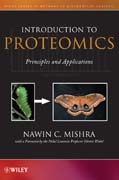
Proteomics provides an introductory insight on proteomics, discussing the basic principles of the field, how to apply specific technologies and instrumentation, and example applications in human health and diseases. With helpful study questions, this textbook presents an easy to grasp and solid overview and understanding of the principles, guidelines, and especially the complex instrumentation operations in proteomics for new students and research scientists. Written by a leader in proteomics studies, Proteomics offers an expert perspective on the field and the future of proteomics. NAWIN C. MISHRA, PhD, is an Emeritus Professor of Molecular Genetics and Genomics at the Department of Biological Sciences at the University of South Carolina. Professor Mishra has also served as a scientific consultant to the FAOof the United Nations, as Chairman of the Program Committee of the Genetics Society of America, and on the review panel of the Human Genome Project for theUnited States DOE. Professor Mishra has published over sixty articles in prominent research journals, including Nature, the Proceedings of the United States National Academy of Sciences, and Genetics. INDICE: Chapter 1 Historical perspectives. 1.1 Introduction to Proteomics.1.2 Proteome and Proteomics. References. Chapter 2 Proteomics - relation to Genomics, Bioinformatics. 2.1 Genomics and Functional Genomics and their utilization in Proteomics. 2.2 Bioinformatics and Computational aspects of Proteomics. References. Chapter 3 Methodology. 3.1 Separation of proteins- via a multidimensional approach. 3.2 Determination of the protein structure. 3.3 Determination of the amount of proteins. 3.4 Structural and Functional Proteomics. References. Chapter 4 Proteomics of Protein Modifications. 4.1 Phosphorylation andphosphoproteiomics. 4.2 Glycoproteins and glycoproteiomics. 4.3 Ubiquitination and ubiquitinomics. 4.4 Miscellaneous modifications of proteins. References.Chapter 5 Proteomics of Protein-Protein interactions /Interactomes. 5.2 In vitro Analysis of Protein Interactions. 5.3 In Silico analysis of Protein-Protein Interactions - Rosetta Stone and other computational analyses. 5.4 SyntheticGenetic method to determine Protein-Protein Interactions. 5.5 Interactomes. 5.6 Evolution and Conservation of Interactomes. 5.7 Interactome and complexity of organism. 5.8 Interaction of proteins with small molecules. References. Chapter 6 Applications. I Application of Proteomics in Medicine: Proteomics, Human Disease and Medicine. 6.1 Diseasome. 6.3 Clinical Proteomics. 6.4 Meta Proteomics and Human Health. II. Application of Proteomics in Biotechnology, Industry & others. 6.5 Biotechnology & Industry of Drug Production. 6. 6. Metaproteomics of Microbial Fermentation. 6.7 Beef Industry. 6. 8. Bioterrorism & Bio-defense. References. Chapter 7 Proteomics - Future. 7.1 Technical Scope of Proteomics - Beyond Protein Identification. 7.2 Scientific scope of Proteomics- Control of Epigenesis. 7.3 Medical Scope of Proteomics. 7.4 Proteomics, Energy Production and bioremediation. 7.5 Proteomics and Biodefense. References.
- ISBN: 978-0-471-75402-2
- Editorial: John Wiley & Sons
- Encuadernacion: Rústica
- Páginas: 180
- Fecha Publicación: 11/06/2010
- Nº Volúmenes: 1
- Idioma: Inglés
